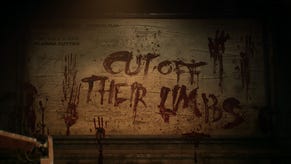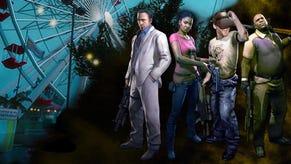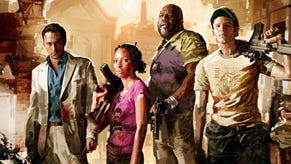Left 4 Dead
No brainer.
When a company like Valve tells you it thinks it has the next Counter-Strike on its hands, you pay attention. Counter-Strike was - and is - an incredibly long-lived global online gaming phenomenon, despite originating as a shoestring amateur mod of the original Half-Life. Valve turns championing the little man into big business, so when the Seattle super-developer invited us to visit and play the fruits of its collaboration with Turtle Rock Studios - a tiny team responsible for AI bots and map design in recent versions of Counter-Strike - we jumped at the chance.
But we had to admit to some surprise and scepticism, too. Left 4 Dead - due this summer on PC, and sometime later on Xbox 360 - is not your average squad shooter. It has no character classes, a very simple weapon set and fairly limited tactical depth. While it does allow player-vs-player conflict, it's essentially not a competitive game. It is, instead, a co-operative survival horror, a frantic, four-player zombie duckshoot in which your aim is to escape maps, not dominate them: an unusual blend of single and multiplayer FPS styles. In the macho world of online shooters, it's a gawky oddball. But that just means that when this year's headlong pile-up of militaristic juggernauts - Quake Wars, Halo 3, even Valve's own Team Fortress 2 - finally happens, Left 4 Dead stands a good chance of sneaking through the wreckage unharmed.
So it's not Counter-Strike, but then it's not Half-Life, either. Like every other aspect of Left 4 Dead, its setting is a model of blunt, purposeful economy, as short and to the point as a shotgun shell to the gut. Almost everyone on Earth has been infected with a virus that turns them into a ravenous flesh-eater, apart from four survivors traced straight from the big book of horror movie archetypes: a rich girl, a tattooed biker, a paranoid war veteran and a blustering store manager. These four find themselves in a desolate, trashed urban setting and have to make their way out, slaughtering numberless hordes of undead mutations along the way. The end. And the beginning. And all points in between.
There are four campaigns, each divided into five maps and representing a serious but manageable chunk of playtime, and designed for replay value above all else. Though the level design is fairly linear, an AI director controls the pace and dynamic of the action, meaning they never play the same twice. The one we play leads through homes, stores, streets, sewers, gas stations, warehouses and a horrific hospital full of screaming zombies in floral smocks, before culminating in the defence of a rooftop radio tower while awaiting helicopter rescue. Rural, wooded settings are also promised, which should provide a welcome change from the convincing but over-familiar concrete and twisted metal.
You begin with a pistol and your choice of shotgun or submachine gun, and Molotov or pipe bomb. Later in the level you can add a second pistol and upgrade to an auto shotgun, heavy assault rifle or sniper rifle, but that's it - Left 4 Dead's weaponry is as resolutely unfancy as its backstory. An effective melee pushes attackers back far enough to get a clear shot. Each player can also carry one first aid kit each, plus pain-suppressant pills (sort of fake health). While ammo isn't much of a problem, health is scarce. Run out and you become incapacitated, lying on the floor but still able to shoot, whereupon a team-mate can revive you up to three times. After the third strike, you'll respawn later in the level in a locked room and need to be let out. If all four players die, it's Game Over.
Turtle Rock is acutely aware from its experience with Counter-Strike that players need firm encouragement to co-operate, so it's made it very difficult to survive if you split off from the group. This is partly down to the sheer numbers of regular infected, but also the designs of the five ‘boss' mutants. The Hunter is a stealth striker capable of huge jumps, that can pin survivors down and needs to be shot off by a team-mate. The Boomer is an explosive walking methane sack that needs to be disposed of clear of any of your friends, and whose projectile vomit attracts huge crowds of lesser infected. The Tank is a straightforward brute, while the Smoker can split team-mates up with smokescreens and lynch them from above with its prehensile tongue. Finally, the terrifying Witch (who only appears on Normal difficulty and above - note that Valve testers currently only survive Normal 20 per cent of the time, and there are two higher difficulty levels) is extremely sensitive to light and sound and best avoided altogether.
All of these except the Witch are playable - you can have four players on the Infected side, bringing the total to 8 - but the zombie experience is deliberately throwaway ("a reefer game," says one Valve bod), a mad dash to cause as much mayhem as possible in between sudden deaths and respawns. At the other end of the scale, three survivors can be controlled by AI bots, making offline play possible; but Valve is keenest on the idea of playing with friends, or at least strangers found through the bespoke matchmaking system it's working on. A tally of achievements based on co-op merits and demerits (rescues versus shots in the back, for example) rather than headshot efficiency and the like, focuses the scoring strictly on collaborative play.
Left 4 Dead is an extremely straightforward proposition to the point that from some angles, it looks like a rather slender one. Is an online shooter with just four chapters, representing as many hours' play between them, really going to survive without the offer of genuinely organised human opposition? On paper, we were worried, but hands-on, concerns melted away like the rotting flesh from a brain-eater's face. The AI director really likes to mix it up: our first playthrough of the level was a gradual crescendo towards a huge climax; the second was stunningly different, characterised by long periods of extremely tense quiet interrupted by sudden, terrifying full-bore zombie assaults.
More importantly, both times were immense fun. Left 4 Dead has a hell-for-leather immediacy and pace that you don't associate with a lot of PC games - hell, not even a lot of console games these days. Everything from weapons to level design to the eerily brilliant AI seems engineered with total economy and precision to do exactly what it needs to, no more, and definitely no less. It's scary and exhilarating and blindingly fast, with team-work refreshingly focusing on instinctive reaction rather than tactical forethought, and a wild sense that anything can happen, and it probably will. We'll only be able to tell if its simple ingredients add up to the recipe for an online smash on the scale of Counter-Strike when the last ingredient, players, is added. But even it doesn't, for those who've been crying out for that rare best - a pure co-operative videogame - Left 4 Dead should be a godsend.









